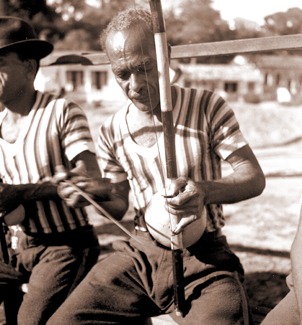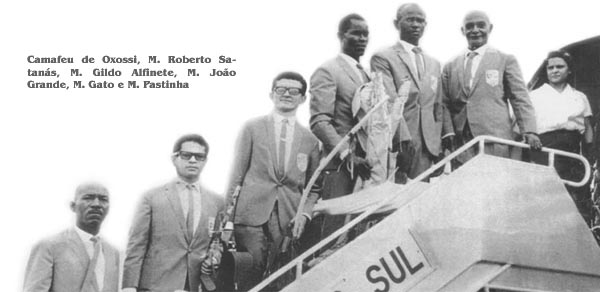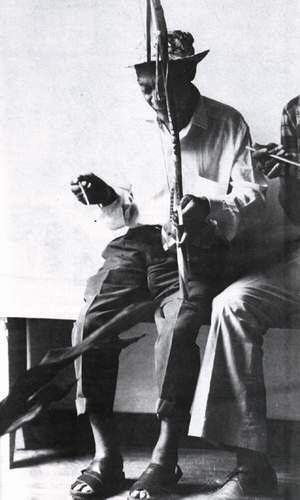Vicente Joaquim Ferreira Pastinha (known to the world as Mestre Pastinha), born on April 5, 1889 in Salvador, Bahia, Brazil– November 13, 1981, was a Mestre (a master practitioner) of the Afro-Brazilian martial art of Capoeira. He is best known for preserving capoeira angola, the more traditional style of capoeira.
Formative Years
Pastinha was born to José Pastinha (born Pastiña), a poor Spanish immigrant who worked as a pedlar and Eugênia Maria de Carvalho Ferreira, a black Bahian homemaker. He was exposed to Capoeira at the age of 8 by an African named Benedito. The story goes that an older and stronger boy from Pastinha's neighborhood would often bully and beat him up. One day Benedito saw the aggression, then told Pastinha to stop by his house because he was going to teach him a few things. In his next encounter with the bully, Pastinha defeated him so quickly that the older boy became his admirer. From then on, Pastinha had a happy and modest childhood. In the mornings he would take art classes at the Liceu de Artes e Ofício school where he learned to paint; afternoons were spent playing with kites and practicing Capoeira. He continued his training with Benedito for three more years. Later, he joined a sailor school by his father wish, which would not support the capoeira practice. At the school, he use to teach capoeira to his friends. At the age of 21, he left the sailor school to become a professional painter. During the spare time he would practice capoeira stealthily, since it was still illegal at that time.
Inheriting Capoeira Angola
 In 1941, by Aberrê's (Pastinha's former student) invitation, Pastinha went to a Sunday roda at "Ladeira do Gengibirra" located at Bairro da Liberdade, where the best Capoeira Mestres would hang out. Aberrê was already famous in these Capoeira rodas, and after spending the afternoon there, one of the greatest Mestres of Bahia, Amorzinho, asked Pastinha to take charge of Capoeira Angola. As a result, in 1942 Pastinha founded the first Angola school, the Centro Esportivo de Capoeira Angola, located at the Pelourinho. His students would wear black pants and yellow T-shirts, the same color as the "Ypiranga Futebol Clube", his favorite soccer team.
In 1941, by Aberrê's (Pastinha's former student) invitation, Pastinha went to a Sunday roda at "Ladeira do Gengibirra" located at Bairro da Liberdade, where the best Capoeira Mestres would hang out. Aberrê was already famous in these Capoeira rodas, and after spending the afternoon there, one of the greatest Mestres of Bahia, Amorzinho, asked Pastinha to take charge of Capoeira Angola. As a result, in 1942 Pastinha founded the first Angola school, the Centro Esportivo de Capoeira Angola, located at the Pelourinho. His students would wear black pants and yellow T-shirts, the same color as the "Ypiranga Futebol Clube", his favorite soccer team.
In March 1963 former executive-secretary of the Danish-Brazilian Chamber of Commerce in São Paulo, Mr. Preben Mailand Christensen, was recommended to visit Mestre Pastinha during his travels in Brazil. In those days Mestre Pastinha was the most famous Capoeiristas of Brazil. During the visit he was offered a personal performance show by Mestre Pastinha himself and his students. He was subsequently given Mestre Pastinha's personal, red calling card with his picture, and presented him with one of Mestre Pastinha's own, old, well-used Berimbaus. In 1963, according to his calling card, he used the expression "Academia Capoeira Angola" for his school in Pelourinho 19, Salvador-BA. He was then 74 years and still very much in good shape.
"Angola, mother of Capoeira. Sorcery of slaves in the longing for freedom; its beginning has no method and its end is inconceivable to even the most knowledgeable capoeirista" – Mestre Pastinha
He participated with the Brazilian delegation of the "First International Festival de Artes Negras" in Dakar, Senegal (1966), bringing with him João Grande, João Pequeno, Gato Preto, Gildo Alfinete, Roberto Satanás and Camafeu de Oxossi.

Twilight Years
 Pastinha worked as a shoe-shiner, tailor, gold prospector, security guard (leão de chácara) at a gambling house (casa de jogo) and construction worker at the Porto de Salvador to support himself financially so that he could do what he loved the most, to be an Angoleiro.
Pastinha worked as a shoe-shiner, tailor, gold prospector, security guard (leão de chácara) at a gambling house (casa de jogo) and construction worker at the Porto de Salvador to support himself financially so that he could do what he loved the most, to be an Angoleiro.
Eventually Pastinha's academy fell on hard times. Pastinha, old, sick and almost totally blind, was asked by the government to vacate his building for renovations. But the space was never returned to him. Instead it became a restaurant and entertainment outlet. Pastinha died a broken man and bitter about his treatment, but never regretted living the life of a Capoeirista. Pastinha was left abandoned in a city shelter (abrigo D. Pedro II - Salvador).
Having dedicated his entire life to Capoeira Angola, he played his last game of Capoeira on April 12, 1981. Pastinha, the father and protector of Capoeira Angola, died at the age of 92 on November 13, 1981. He was survived by two of his most learned students, João Grande and João Pequeno (died 2011) who continued to share Pastinha's Capoeira Angola with the world.
C. Daniel Dawson would later write:
"Pastinha was a brilliant Capoeirista whose game was characterized by his agility, quickness and intelligence (…). Pastinha wanted his students to understand the practice, philosophy and tradition of pure Capoeira Angola. As he said, "I practice the true Capoeira Angola and in my school they learn to be sincere and just. That is the Angola law. I inherited it from my grandfather. It is the law of loyalty. The Capoeira Angola that I learned - I did not change it here in my school… When my students go on they go on to know about everything. They know; this is fight, this is cunning. We must be calm. It is not an offensive fight. Capoeira waits (…). The good Capoeirista must know how to sing, play Capoeira and the instruments of Capoeira" - Excerpt from Capoeira Angola and Mestre João Grande by C. Daniel Dawson
For more information about Mestre Pastinha's manuscript, go to: http://www.aldeiacapoeira.com/MestrePastinhaManuscritos.html
